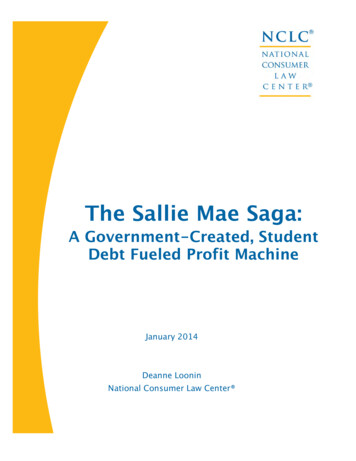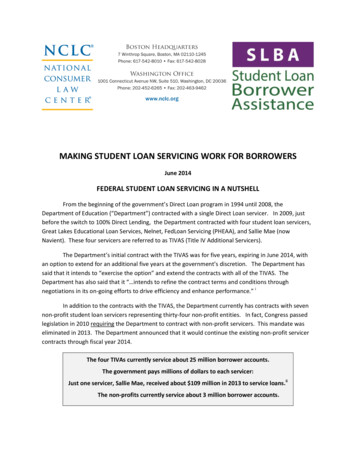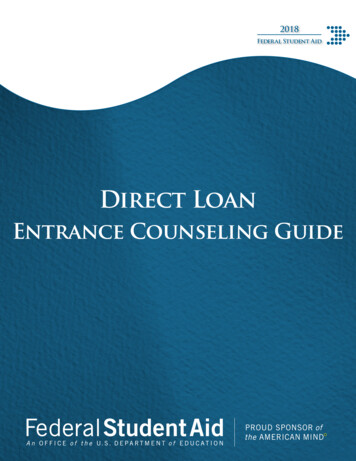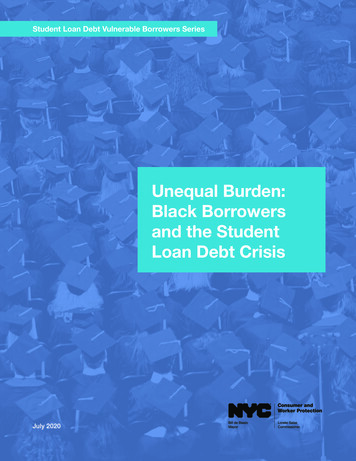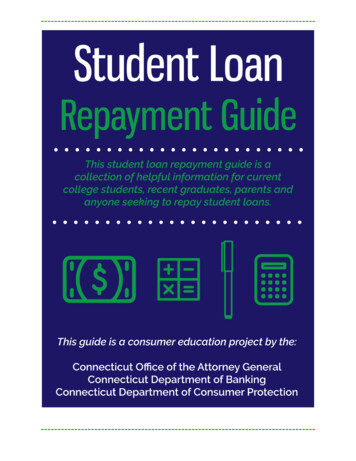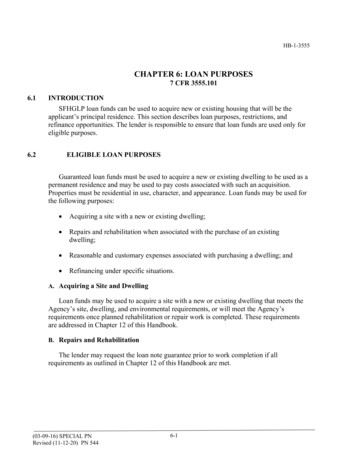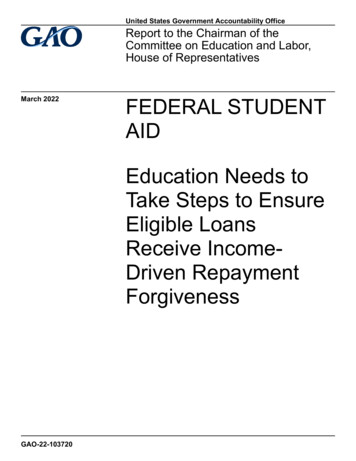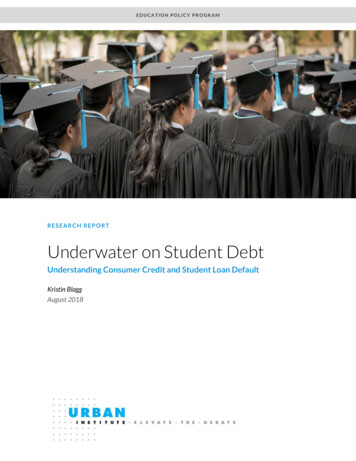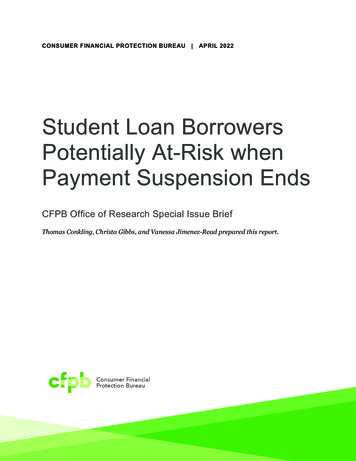
Transcription
CONSUMER FINANCIAL PROTECTION BUREAU APRIL 2022Student Loan BorrowersPotentially At-Risk whenPayment Suspension EndsCFPB Office of Research Special Issue BriefThomas Conkling, Christa Gibbs, and Vanessa Jimenez-Read prepared this report.
Introduction and summary of findingsBased on a recent analysis by the U.S. Government Accountability Office (GAO), more than 26million student loan borrowers have had their federal student loan payments suspended duringthe economic upheaval caused by the COVID-19 pandemic. 1 While some of the pandemic’simmediate employment-related shocks may be past, resumption of payments could still posechallenges for student loan borrowers. In this report we use data from the CFPB’s ConsumerCredit Panel (CCP) to identify which types of borrowers might struggle to make their scheduledloan payments based on five potential risk factors: pre-pandemic delinquencies on studentloans, pre-pandemic payment assistance on student loans, multiple student loan servicers,delinquencies on other credit products since the start of the pandemic, and new third-partycollections during the pandemic. 2 Although many factors affect student loan repayment, wefocus on these factors visible in the CCP because they either directly involve borrowers’interactions with their student loan servicers or they allow us to monitor ongoing risks at a timewhen student loan payments have not been required. 3The pandemic has brought job losses and financial uncertainty, but government policyinterventions likely helped to avoid more widespread distress. For example, Congress passed theCoronavirus Aid, Relief, and Economic Security (CARES) Act early in the pandemic, which,among other things, put federally owned student loan payments on hold, temporarily reducedinterest rates on federally owned loans to 0 percent, and cured non-defaulted delinquencies forall federally owned student loans until September 30, 2020. 4 Subsequent administrative actionsextended this relief several times, with the latest extension scheduled through August 31, 2022. 5Such actions may have helped improve the credit conditions and financial status of the average1See U.S. GAO “COVID-19: Significant Improvements Are Needed for Overseeing Relief Funds and LeadingResponses to Public Health Emergencies,” (January 2022) available at tml#appendix8 (hereinafter GAO 2022).2GAO reported that the Department of Education similarly identified three groups of borrowers potentially atincreased risk of delinquency: those who did not complete their program of study, those previously delinquent ontheir student loans, and those who had entered repayment within the past three years (GAO 2022). Our data do notinclude information on program completion so we cannot include that in our analysis. We do not use recent entryinto repayment as one of the factors we in our analysis, but we show how our factors vary for those not previously inrepayment.3We validate and discuss the correlation of these risk factors with student loan delinquency in more detail below.4WHO declared COVID-19 a pandemic on March 11, 2020, and the CARES Act was passed and signed into law twoweeks later. For more information on timing of events during the pandemic, see “A Timeline of COVID-19Developments in 2020” available at velopments-in-2020.5See 19 for more information. For ease of reading, we use theterm “CARES Act payment suspensions,” or similar, to refer both to the statutory payment suspension andsubsequent administrative actions extending that relief.1STUDENT LOAN BORROWERS POTENTIALLY AT-RISK WHEN PAYMENT SUSPENSION ENDS
consumer during the pandemic, but not all consumers have fared as well financially. 6 Asforbearances, Economic Impact Payments and other financial assistance, and paymentsuspensions end, more borrowers may struggle to make their payments.Prior to the pandemic, more than one in four student loan borrowers were past due or receivingsome type of payment assistance on their student loans. Delinquencies across all credit productsand available credit improved for student loan borrowers after February 2020, but this generalimprovement might reflect an increase in financial support or an easing of their monthlypayment obligations. The median student loan borrower making payments prior to thepandemic has saved 133 each month due to the federal student loan payment suspension, andmany borrowers had substantially larger savings. The payment suspension’s end will requirestudent loan borrowers to resume making roughly 6 billion per month in aggregate payments.Although some borrowers might resume payments without serious issues, many borrowers maystruggle: we find that over 5 million borrowers have at least two of five potential risk factorsconsidered in this report. We also find that borrowers with multiple risk factors are more likelyto live in low-income or high-minority census tracts. With the record number of borrowersentering repayment at once, recent servicing changes, and many unresolved financial difficultiesfrom well before the pandemic, millions of borrowers might face a difficult road after pandemicrelated relief expires. 7Data and sampleThe CCP is a 1-in-48 deidentified longitudinal sample of credit records from one of thenationwide consumer reporting agencies. The data include account-level payment, balance, anddelinquency information on student loans and other credit accounts (including credit cards,auto loans, mortgages, and third-party collections). 8 However, credit record data do not includedirect identifiers for whether loans are federally-held. As a result, some of the loans in this6See, for example, Fulford, Rush, and Wilson, “Changes in consumer financial status during the early months of thepandemic: Evidence from the second wave of the Making Ends Meet survey” (April 2021) available s-duringearly-months-pandemic/ (hereinafter Fulford, Rush, and Wilson (2021).7See “Report of the CFPB Education Loan Ombudsman” 2021 report for more detail on some of these tion-loanombudsman/.8Because credit data do not include information on demographics (other than age), we use the most recentlyavailable the census tract-level five-year estimates from the American Community Survey to categorize borrowersinto approximate neighborhood income and racial composition categories. All characteristics are based on theborrower, even if the loan was used to finance someone else’s education.2STUDENT LOAN BORROWERS POTENTIALLY AT-RISK WHEN PAYMENT SUSPENSION ENDS
analysis are private loans or federal loans held by private lenders, 9 neither of which are coveredby the CARES Act and subsequent administrative actions and are not directly affected by thepayment suspension. 10We focus on consumers in the CCP who had student loans before the pandemic and may havescheduled payments come due after the payment suspension ends. To do this, we start with allstudent loans in the CCP and impose a few sample restrictions. First, we restrict our sample torecords with outstanding student loans in February 2020, before the start of the pandemic’swidespread health and economic effects in the United States. 11 This leaves us with a samplerepresenting 44 million student loan borrowers before the pandemic. We exclude theapproximately 3.6 million consumers who newly borrowed a student loan since March 2020because these borrowers do not have a pre-pandemic baseline and because most of theseborrowers will still be in deferment when the payment suspension ends. Borrowers who werenot in repayment (that is, those with loans in deferment, forbearance, or grace period) as ofFebruary 2020 are included in this analysis. 12Next, we exclude the roughly 10 percent of borrowers who had entered repayment before thestart of the pandemic but who did not have a scheduled payment. One such group we excludeare borrowers on an income-driven repayment (IDR) plan with scheduled payments of 0 who,due to policy interventions, will still likely not need to make payments when the suspension9The shares of borrowers in different groups (such as those with a delinquency or with payment assistance) inDepartment of Education data generally align with the shares of borrowers in the CCP, but there are somedifferences as a result of the inclusion of private and privately-held loans and the proxies we use in our analysis, asdiscussed below. Additionally, we exclude some types of borrowers that would likely appear in the Department’sdata which results in further differences from the statistics shown in this analysis. See “Federal Student LoanPortfolio” available at io (hereinafter “Federal Student LoanPortfolio”) for more information.10Borrowers may have still received some relief on their private loans or federal loans held by private lenders duringthe pandemic in the form of forbearances, for example, but such assistance was not universal, and borrowerstypically had to request assistance. Additionally, changes in any assistance borrowers received for such loans isunlikely to change when the payment suspension ends.11The CCP is based on snapshots near the end of the month, but accounts are reported (with some lag) throughoutthe course of the month to the nationwide consumer reporting agencies. As a result, the status of accounts may spanmultiple months which causes some complexity in defining the timing of the pre-pandemic periods. For all productswe use the March 2020 snapshot for the pre-pandemic period. Student loans’ statuses are typically observed as ofthe end of the prior month, so our pre-pandemic student loan statuses are most commonly from February 2020.Other credit products typically have statuses reported early-to-mid-month, so for these products our pre-pandemicstatuses are most commonly from early-to-mid March 2020. The data in both cases should represent the mostrecently available status of these accounts before the major policy responses and economic effects of the pandemic.12Some of these borrowers may continue to have loans in deferment or forbearance when the payment suspensionends. However, the credit data do not allow us to identify which loans might qualify for in-school deferments orgrace periods and which loans will be entering repayment. As a result, our sample is likely over inclusive of thisgroup, but this group is likely younger and has fewer other credit products and is less likely to have the risk factorsconsidered in this analysis.3STUDENT LOAN BORROWERS POTENTIALLY AT-RISK WHEN PAYMENT SUSPENSION ENDS
ends. 13 To maintain our focus on borrowers who may struggle to make their payments when thesuspension ends, we also exclude borrowers with only loans in default as of February 2020,though these borrowers are by definition in serious financial distress. 14 In fact, at the start of thepandemic, many, if not most, of these borrowers were not making any regularly scheduledpayments under, for example, a collections agreement or the loan rehabilitation program. 15When the federal student loan payment suspension ends, borrowers with defaulted federal loanswho are not subject to a recent rehabilitation agreement or who have not otherwise resolvedtheir defaults, will not be subject to an automatic resumption of regularly scheduled paymentsunder policies in effect as of this writing. 16 While both groups of borrowers likely experiencefinancial distress, they are outside the focus of this report because they will not resume typicalactive repayment when the payment pause ends. 17In contrast, about 12 percent of borrowers fully paid off all their loans or had them forgivenduring the pandemic as of data reported in late February 2022. Compared to the rest of thesample, these borrowers were generally older (median age of 41 versus 35) and had loweroutstanding student loan balances (median of 8,444 versus 21,960) in February 2020. Aswith the above groups, we exclude these borrowers from this analysis since they will not haveany payments due when the payment suspension ends.13As discussed below, ED has announced that borrowers enrolled in IDR plans before the suspension will not need torecertify their enrollment until at least November 2022 to maintain their pre-pandemic scheduled payments,including those with scheduled payments of 0. See “COVID-19 Relief: Income-Driven Repayment (IDR) Plans”available at 19/income-driven-repayment.14These borrowers are still responsible for the full unpaid balance of their loans. This is true for private and federaleducation loans, both of which are subject to post-default collections. While in default, federal student loans are noteligible for income-driven repayment plans or any of the deferment and forbearance options available for nondefaulted federal loans.15The payment suspension for federal student loans initiated under the CARES Act also includes a suspension ofinvoluntary and voluntary collection of defaulted federal loans. Involuntary collection efforts include AdministrativeWage Garnishment and the Treasury Offset of Social Security retirement benefits and federal tax refunds. Voluntarydefault resolution options include payments scheduled under a formal loan rehabilitation agreement. After aborrower successfully makes the nine payments required under the rehabilitation agreement, the default is “cured”and the loans are placed into a non-default status and transferred to a servicer, which will establish a new paymentschedule. Rehabilitation payments, which can run as low as 5 a month, have been suspended under the pause, andgiven the duration of the suspension (now scheduled to last more than two years), borrowers who were makingpayments under a “rehab” plan prior to the start of the pandemic will have successfully rehabilitated their defaultedfederal loans. Unless a deferment or forbearance is arranged, these loans will resume repayment after the federalpayment suspension ends. Rehabilitated federal student loans are eligible for income-based repayment plans;however, IDR options for Parent PLUS loans are limited.16Borrowers with loans in default may again be subject to involuntary collection efforts after the CARES Actsuspension ends.17Borrowers with scheduled 0 IDR payments, for example, have low incomes which may generally make repaymentdifficult for them in the absence of IDR plans. Borrowers with loans in default, meanwhile, have a clear history ofnonpayment which may suggest broader financial difficulties. For more information on characteristics of theseborrowers, see Appendix Table A.1.4STUDENT LOAN BORROWERS POTENTIALLY AT-RISK WHEN PAYMENT SUSPENSION ENDS
With these restrictions, our sample represents around 34 million student loan borrowers, about80 percent of all student loan borrowers in the CCP, including those with private loans andthose with loans which had not yet entered repayment as of February 2020. We includeborrowers whose scheduled monthly payments did not decrease to 0 to account for borrowerswith federally owned loans covered by the payment suspension who also have other loans (eitherprivate loans or privately-owned loans). 18 Our inclusion of borrowers who had not yet enteredrepayment is the primary reason why our sample of 34 million is larger than GAO’s estimate of26.6 million borrowers likely to re-enter repayment when the suspension ends. The CCP data donot include information on borrowers’ enrollment status so we cannot directly exclude thosewho will still be in school when the suspension ends.Finally, credit record data do not directly indicate whether student loans are in an IDR plan, oneof the potential risk factors we consider in this analysis. To estimate which borrowers werereceiving payment assistance pre-pandemic, mostly likely through enrollment in an IDR plan,we categorize all non-deferred student loans in our restricted sample with inferred interest ratesbelow 2.875 percent as of February 2020 as receiving payment assistance. 19In the analyses that follow, we present our five potential risk factors. We do not attempt toestablish these factors as causing student loan delinquencies, but we validated that student loandelinquencies are positively correlated with all five factors in pre-pandemic data usingregression analysis (not shown). Specifically, student loan delinquency in February 2020 waspositively correlated with having multiple student loan servicers, use of payment assistance,delinquencies on non-student loans, delinquencies on student loans, and new non-medicalcollections reported between March 2018 and December 2019. 20 In the case of a risk factor like18As shown below, 17 percent of borrowers in our sample have multiple servicers. A borrower with multiple servicerslikely has multiple kinds of federal loans or a mix of federal and private loans. As a result, excluding these borrowersmight undercount the set of borrowers affected by the payment suspension who may be at-risk of difficulties whenthe suspension ends.19This proxy is an incomplete measure of IDR enrollment that is more likely to underestimate the share of borrowersenrolled in IDR relative the share reported by the Department of Education for all federally held student loans. Forexample, very few fixed or variable rate federal loans had rates below 2.875 percent as of February 2020, thoughsome private student loans and older FFELP and Direct loans may have had rates this low. However, some loansenrolled in an IDR plan may have inferred rates above 2.875 percent and would not be identified by this measure.Specifically, our estimated rate of IDR prior to the pandemic (Table 1) is slightly below the Department’s rate (17versus 21 percent, see io). Looking at all student loans inrepayment (including those in default or with 0 scheduled payments), our estimated rate of IDR increases to 21percent and aligns with the Department’s rate (not shown). For more information and other methods on proxyingfor loans enrolled in an IDR plan, see Conkling and Gibbs, “Borrower experiences on income-driven repayment”(November 2019) available at -driven-repayment/.20The March 2018 to December 2019 period that roughly matches the duration of the CARES Act paymentsuspensions as of this writing. While payment assistance is designed to improve student loan repayment, borrowerswho need payment assistance are more likely to be struggling, and our sample excludes borrowers whose paymentshave been lowered to 0, since they will not be required to make payments when the suspension ends.5STUDENT LOAN BORROWERS POTENTIALLY AT-RISK WHEN PAYMENT SUSPENSION ENDS
receiving payment assistance, this is an indicator of borrowers taking action to try to avoiddelinquency. These factors are also consistent with those analyzed in Mezza and Sommer(2016), which focused on predicting delinquencies to better target outreach to borrowers. 21In Table 1 we provide a baseline picture of borrowers’ student loan finances prior to thedisruptions of the pandemic, including our student loan-related potential risk factors. 22 In Table2 we introduce statistics on non-student loan products for the same pre-pandemic period, whileTable 3 and Figure 1 highlight our potential risk factors based on these other credit productsusing more up-to-date data. Finally, in Table 4 we show how borrowers’ balances and paymentshave evolved through the pandemic and provide a summary of our potential risk factors.Throughout this report, we provide overall statistics, as well as shares and averages for differentgroups of borrowers, such as by prior student loan delinquency status, census tract income andracial composition, and borrower age, in order to provide more information about which typesof borrowers may be vulnerable when the payment suspension ends.Before CARES Act and COVID policy interventionsAs seen in Table 1, 7 percent of student loan borrowers had at least one student loan 90 days ormore past due as of February 2020, which we define as the pre-pandemic period. 23 Loans thatwere delinquent (but not in default) were administratively cured through the CARES Act, 24 butin many cases the underlying causes of these delinquencies are unlikely to have been addressedduring the pandemic, so these borrowers may still struggle to make loan payments once reliefends. Additionally, about 18 percent of borrowers appear to have never been in repayment priorto the pandemic (Table A.2), and their first transition into repayment may present heightened21Our data do not include all the factors in Mezza and Sommer (2016) such as college completion and grant use, sowe can only include a subset of those they consider. We also consider some factors not included in their analysissuch as the use of income-driven repayment plans which were much less commonly used in the period theyanalyzed. See Mezza and Sommer, “A Trillion Dollar Question: What Predicts Student Loan Delinquencies?,”Journal of Student Financial Aid (2016), available at 3.22Throughout the report, all statistics are calculated using all loans reported for borrowers, regardless of whethersome or all their loans are individual or cosigned. The credit record data do not allow us to determine whether theborrower has made arrangements with someone else to repay the loan.23For comparison, the Department of Education reports just over 5 percent of all federally managed studentborrowers had loans that were 90 or more days past due but not in default at the end of 2019, but those data includeloans with scheduled payments of 0 and loans which were fully repaid during the pandemic and do not includeprivate student loans. Excluding borrowers not yet in repayment, the share increases to 9 percent of borrowers withloans 90 days or more past due but not in default. See “Federal Student Loan Portfolio.”24Delinquent loans held by the federal government were changed to current without any payments made byborrowers to resolve the delinquencies. Defaulted federal student loans were not administratively cured through theCARES Act or any subsequent administrative action, although collection efforts were halted. Borrowers could usethe payment suspension to count as 0 payments that would rehabilitate their loans, but take up of that optionappears to have been low as 7.2 million borrowers were still in cumulative default as of June 2021 (see “FederalStudent Loan Portfolio.”).6STUDENT LOAN BORROWERS POTENTIALLY AT-RISK WHEN PAYMENT SUSPENSION ENDS
risks given the long delay in starting repayment, the large number of borrowers enteringrepayment, and recent servicing transfers.Borrowers in our sample had an average monthly payment of 236 before the pandemic, whichincludes 18 percent of borrowers not in repayment and the 17 percent of borrowers who werereceiving some form of payment assistance on their student loans in February 2020, typicallyvia an IDR plan. 25 Among those in the sample not in an IDR plan and who did not have somesort of deferred payment, the average monthly payment was 322 (not shown). UnderDepartment of Education policy at the time of this writing, borrowers enrolled in IDR before thepayment suspension will not need to immediately recertify their enrollment in these plans priorto the payment restart but can seek to reduce their IDR payments if they have had a reduction intheir income. 26 The Department of Education has also eased some IDR enrollment andrecertification processes during the pandemic, 27 aiding the upcoming transition for borrowers.Still, with an unprecedented number of borrowers entering or re-entering repaymentsimultaneously, those who need to work with their servicer(s) to change their IDR enrollment orother payment details (including opting back into or changing their auto-debit or updating theircontact information) could face logistical hurdles to making timely payments.Most borrowers have just one servicer for their student loans, but borrowers can have multipleservicers if they have both federal and private student loans or if they have multiple types offederal student loans. Before the pandemic, about 17 percent of student loan borrowers in oursample had more than one servicer. Having multiple servicers does not necessarily meanborrowers will face greater difficulties, but some of these borrowers may be at increased risk ofconfusion or payment difficulties while coordinating communication and payments withmultiple entities, especially as servicers work to add staff following a long period without asmuch need for customer service support and during a tight labor market. 28 The Bureau throughits supervisory work has previously found that student loans servicers were denying or failing to25As noted above, this estimate does not include those with a scheduled payment of 0. When those borrowers areincluded, our estimate of the share of borrowers on an IDR plan more closely aligns with data reported by theDepartment of Education (see “Federal Student Loan Portfolio”).26Borrowers enrolled in an IDR plan will eventually need to recertify their enrollment, but the earliest recertificationdate is currently November 2022, several months after the end of the payment suspension. See “COVID-19 Relief:Income-Driven Repayment (IDR) Plans” available at 9/income-driven-repayment.27For more information on IDR enrollment changes during the pandemic including allowing borrowers to self-certifytheir income, see 19/income-driven-repayment. Additionally,see GAO (2022) for a discussion of specific actions taken by the Department of Education and planned flexibilitiesonce the suspension ends.28GAO recently reported that federal student loan servicers expect higher call volume from borrowers as thesuspension ends and an increased hiring need and that the Department of Education will require servicers toincrease customer service representative availability. See GAO (2022).7STUDENT LOAN BORROWERS POTENTIALLY AT-RISK WHEN PAYMENT SUSPENSION ENDS
approve qualified consumers for income-driven repayment plans 29 and misrepresenting theeligibility of the Federal Family Education Loan Program loans for Public Service LoanForgiveness (PSLF), the employer types that qualified for PSLF, and the effect of employercertification forms. 30TABLE 1:PRE-PANDEMIC STUDENT LOAN (SL) STATUS, FEBRUARY ncyassistanceservicersmonthly SLMean SL(%)on SL (%)for SL (%)payment ( )balance ( 06High5171927144,77318 295111712125,82530 498221928448,096OverallCensus tract income:LowAge:50 6161530746,877Note: All statistics are calculated for student loan borrowers who may have a payment due when thesuspension ends and who had an outstanding student loan in February 2020. Student loan delinquenciesinclude loans 90 days or more past due but not yet in default. Receipt of payment assistance on a studentloan is proxied by inferred interest rates less than 2.875 percent. Census tract categories are defined byadults in the tract with household income below 200 percent of the Federal poverty threshold; “low”income is 40 percent or more of adults, “moderate” income is 20 percent or more but less than 40 percentof adults, and “high” income is less than 20 percent of adults.In addition to these headline numbers, we also show how borrowers’ financial situations variedsubstantially across demographics including neighborhood income and borrower age before thepandemic. 31 For example, delinquency rates were more than twice as high among borrowers inlow-income census tracts (11 percent) as among those in high-income census tracts (529See CFPB, “Supervisory Highlights: Issue 13,” (Fall 2016) at 17 available pervisory Highlights Issue 13 Final 10.31.16.pdf.30See CFPB, “Supervisory Highlights: Issue 24,” (Summer 2021) at 34 36 available pb supervisory-highlights issue-24 2021-06.pdf.318We chose these demographic groups based on characteristics those without credit record information (such as theDepartment of Education, student loan servicers, and advocacy groups) might be able to target outreach to. We alsolooked at groups of borrowers based on total student loan balances, local unemployment rates, and whetherborrowers are in urban or rural tracts, but found relatively small differences in these groups (not shown). SeeAppendix Table A.2 for the share of borrowers in each of these groups, as well as median payments and the share ofborrowers with other credit products.STUDENT LOAN BORROWERS POTENTIALLY AT-RISK WHEN PAYMENT SUSPENSION ENDS
percent). 32 Note that these census tracts reflect borrowers’ current neighborhoods (and proxyfor current incomes) rather than where they lived prior to attending school. In Appendix TableA.3, we show similarly elevated delinquency rates for student loan borrowers in high-minoritycensus tracts relative to those in low-minority census tracts. Additionally, borrowers aged 30 49were more likely to have a delinquent student loan (8 percent), use payment assistance (22percent), or have multiple servicers (19 percent) than either younger or older borrowers. Finally,there is wide variation in average student loan balances across different groups of borrowers,with the highest balances
The median student loan borrower making payments prior to the pandemic has saved 133 each month due to the federal student loan payment suspension, and many borrowers had substantially larger savings. The payment suspension's end will require student loan borrowers to resume making roughly 6 billion per month in aggregate payments.

